|
Gaojiasuo yuxi
高加索语系 Caucasian family 指分布于高加索山脉南北、黑海和里海之间高加索山区的许多语言所包括的语言众说不一,从30~40种不等。使用人口约 500万。分南、北两个语族。 南部语族有格鲁吉亚语明格雷利亚语、拉兹语和斯凡语。这些语言的语音比较一致,只是元音系统有些不同。除了斯凡语以外,元音没有长短的区别。塞音和塞擦音有清、浊和喉塞3类。辅音丛很常见,有多达6~8个辅音的辅音丛,如格鲁吉亚语prckvna(剥皮)。语法屈折形式很多,动词分人称、数(单、复数)、时、体、语气、语态、使役和确定主宾关系的特殊格式。这些范畴主要用前缀、后缀表示,也用动词词干内部屈折表示。动词变化复杂,在动词上加特定的前缀,就能表示动词的主语和直接、间接宾语,如格鲁吉亚语:m- 图片:200722115143643.jpg  er-s(他写给我),m-xa er-s(他写给我),m-xa图片:200722115143305.jpg  av-s(他画我),其中m表示作为宾语的“我”,s表示作为主语的“他”。名词性的词有格的变化,其数目从6~11个不等。名词性的词不分性别;也没有特别的冠词。句法的基本结构是主语-宾语-动词,但主语-动词-宾语的句型也很常见。特点是有唯被动结构,其中及物动词的主语用动者格表示,而真正的直接宾语用不及物动词的主语(传统上叫主格)表示。南部语族诸语言有共同的词汇,包括亲属词、动、植物名称、人体各部位名称、表示人类各种活动的词,等等。 av-s(他画我),其中m表示作为宾语的“我”,s表示作为主语的“他”。名词性的词有格的变化,其数目从6~11个不等。名词性的词不分性别;也没有特别的冠词。句法的基本结构是主语-宾语-动词,但主语-动词-宾语的句型也很常见。特点是有唯被动结构,其中及物动词的主语用动者格表示,而真正的直接宾语用不及物动词的主语(传统上叫主格)表示。南部语族诸语言有共同的词汇,包括亲属词、动、植物名称、人体各部位名称、表示人类各种活动的词,等等。
北部语族分西北和东北两个语支。西北语支的主要语言是卡巴尔达语,通行于卡巴尔达-巴尔卡尔苏维埃社会主义自治共和国,使用人数约32万;此外,还有阿布哈兹语、阿迪格语、阿巴齐尼亚语等。东北语支约有30种语言,主要语言是车臣语和印古什语,前者使用人数约60万,后者约15万,二者通行于车臣-印古什苏维埃社会主义自治共和国;此外,还有阿瓦尔语、莱兹金语、拉克语、达尔金语、列兹吉语和塔巴萨兰语等。西北语支诸语言的特点是:元音少,辅音多,有些语言达七八十个。除了有南高加索诸语言的所有辅音之外,还有唇化辅音、硬辅音、半嘘辅音和软颚化辅音。名词系统非常简单,动词变位比较复杂。有些语言没有语法上的格,有些语言有两个格。名词的领属关系用代词性前缀表示。动词的特点是:多为多式综合词,即不同的词结合在一起,构成复合词,作为一个完整的陈述。前缀表示最重要的动词范畴。在人称标记之后的前缀表示状语。句中词序多为主语―宾语―动词。简单句有 3种结构:不定、主格和唯被动结构,分别用不定格、主格、动者格表示这3种句子的主语。东北语支诸语言的特点:语音系统的成分丰富。基本元音有5个:a、e、i、o、u。此外,在一些语言中还有鼻化长元音,喉化、唇化元音。在车臣语中,元音系统复杂,区别性元音达30个之多(包括二合元音和三合元音),多数语言有强势辅音和非强势辅音的对立。词法的共同特征是按类别划分名词,例如“物”类和“人”类,“人”类又细分为“男人”类和“女人”类。名词格的变化繁多。句中词序多为主语―宾语―动词,特点是有唯被动结构的句子,复杂句通常由分词-形容词和分词-状语结构构成。北部语族诸语言保存许多本族词,但也有相当数量来自阿拉伯语、突厥语、波斯语的借词。在近代和现代、俄语是借词的主要来源。 高加索语系主要的语言都采用以基里尔字母为基础的文字。 参考书目 B. Comrie, he Languages of the Soviet Union,Cambridge University Press, 1981。 M. Ruhlen , A Guide to the Languages of the World , Language Universals Project, Stanford University, 1975, 1976. [ 本帖最后由 小菜菜 于 2008-6-4 08:51 编辑 ] |
|
最新喜欢: |
|
沙发#
发布于:2014-05-26 10:40
用户被禁言,该主题自动屏蔽! |
|
|
板凳#
发布于:2014-05-26 10:38
用户被禁言,该主题自动屏蔽! |
|
|
地板#
发布于:2008-06-04 12:47
高加索语系------拉克语
拉克语属于北高加索语族的那契斯克--达吉斯坦支,在俄罗斯境内的达吉斯坦自治共和国内主要有100,000 使用者。在阿塞拜疆,格鲁吉亚,哈萨克斯坦,吉尔吉斯斯坦,塔吉克斯坦,土耳其,土库曼斯坦,乌克兰和乌兹别克斯坦也有一些使用者。拉克语和达尔格瓦语很相近。
以1928年为界,之前,拉克语使用阿拉伯字母书写;后来直到1938年,拉克语采用拉丁字母书写。从1938年开始,拉克语采用西里尔字母书写。 Lak (Лакку маз) Lak belongs to the Nachsko-Daghestan branch of North Caucasian languages and is spoken by about 100,000 speakers mainly in the Russian republic of Dagestan. There are also speakers of Lak in Azerbaijan, Georgia, Kazakhstan, Kyrgyzstan, Tajikistan, Turkey, Turkmenistan, Ukraine and Uzbekistan. Lak is closely related to Dargwa. Lak was written with the Arabic alphabet 1928, when the Latin alphabet was adopted. Since 1938 a version of the Cyrillic alphabet has been used to write Lak. |
|
|
4#
发布于:2008-06-04 12:38
高加索语系------卡巴尔达语
卡巴尔达语是西北高加索语族的一种语言,在俄罗斯境内的卡巴尔达--巴尔卡尔自治共和国和卡拉恰耶夫---切尔克斯自治共和国使用;在土耳其,沙特阿拉伯,约旦和美国使用。卡巴尔达语也被称作东切尔克斯语或上切尔克斯语。
1923年,卡巴尔达语开始用拉丁字母书写;从1936年起,开始使用西里尔字母书写。同高加索语系的许多其他语言,卡巴尔达语有非常少的元音字母和繁多的辅音字母。一些辅音字母书写时由4个字母构成,如Кхьу这个字母,就是一个四合字母。 Kabardian (къэбэрдеибзэ) Kabardian is a North West Caucasian language with about 650,000 speakers mainly in the Kabardian-Balkar and Karachay-Circassian Republics of Russia. It is also spoken in Turkey, Saudi Arabia, Jordan and the USA. Kabardian is also known as East Circassian or Upper Circassian. Kabardian first appeared in writing in 1923 in a version of the Latin alphabet. Since 1936 it has been written with the Cyrillic alphabet. Like other Caucasian languages, Kabardian has very few vowels and a large number of consonants. Some of the consonants are written using combinations of as many as four letters. 另一段英文介绍: Kabardian is spoken in the Caucasus region of the Russia, principally in the Kabardin-Balkar Republic (capital: Nalchik) and the Karachai-Cherkess Republic (capital: Cherkessk). It is spoken by two peoples—the Kabardians, who number about 325,000, and the Circassians (Russian: cherkesy), who number about 50,000. The language is thus sometimes referred to as Kabardin-Cherkess. The Kabardians, Circassians, and a third people, the Adygeis, who speak the closely related Adygei language, are sometimes referred to collectively as Circassians. Historically, the Circassians date back to ancient times, and until the middle of the 19th century occupied almost the entire region between the Caucasus Mountains, the Kuban River, and the Black Sea. Following the annexation of the region by Russia in 1864, several hundred thousand Circassians migrated south and some are still to be found today in Turkey and Syria. Kabardian belongs to the Western branch of the Caucasian family of languages. The alphabet is Cyrillic with only one additional letter—the I—which is common to many of the Caucasian languages. 卡巴尔达语书写范例: 图片:卡巴尔达语书写范例.gif 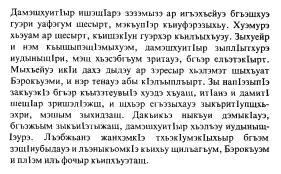 [ 本帖最后由 小菜菜 于 2008-6-4 12:39 编辑 ] |
|
|
5#
发布于:2008-06-04 12:35
高加索语系------塔巴萨兰语
塔巴萨兰语是东北高加索语支的一种语言,在俄罗斯境内的达吉斯坦自治共和国,一个拥有14种官方语言的国家,大概拥有100,000 使用者。在阿塞拜疆,哈萨克斯坦,土库曼斯坦,乌兹别克斯坦也有该种语言的使用者。塔巴萨兰语大体上分为2种方言:南塔巴萨兰语和北塔巴萨兰语。塔巴萨兰语的书写系统建立在南塔巴萨兰语的基础上。
从20世纪初到1928年,塔巴萨兰语采取阿拉伯字母书写,继而,又运用拉丁字母进行塔巴萨兰语的书写,1937年,塔巴萨兰语开始采用一种变体西里尔字母进行文字语言书写。 Tabassaran (табасаран чIал) Tabassaran is a North East Caucasian language spoken by about 100,000 people mainly in the Russian republic of Dagestan, where it is one of the 14 official state languages. There are also speakers of Tabassaran in Azerbaijan, Kazakhstan, Turkmenistan, and Uzbekistan. There are two main dialects of Tabassaran: Southern Tabassaran and Northern Tabassaran, and written Tabassaran is based on the southern dialect. From the beginning of the 20th Century to 1928, Tabassaran was written with the Arabic alphabet, after which it was written with the Latin alphabet. Then in 1937 a version of the Cyrillic alphabet was adopted to write Tabassaran. |
|
|
6#
发布于:2008-06-04 12:33
高加索语系------斯万语
斯万语是一种南高加索语族的语言,在格鲁吉亚西北部,在阿布哈兹自治共和国内,也不乏斯万语的使用者。
在格鲁吉亚,斯万语没有官方地位,也没有标准书写形式。当书写,虽然拉丁字母和西里尔字母的书写系统也偶尔被使用,但一种变体格鲁吉亚字母的使用仍占主要地位。 Svan (ლუშნუ ნინ/შკა̈ნ) Svan is a South Caucasian language spoken by about 30,000 people in in the northwest of Georgia. There are also several thousand Svan speakers in the republic of Abkhazia. Svan has no official status in Georgia and there is no standard written form. When it is written, a version of the Georgian alphabet is usually used, though the Cyrillic and Latin alphabets are also used occasionally. |
|
|
7#
发布于:2008-06-04 12:32
高加索语系------拉兹语
拉兹语属于南高加索语族,在黑海周围大概有33,000 人的使用者,主要分布在,土耳其东北部和格鲁吉亚。拉兹语和明格雷利亚语十分相近,虽然两种语言不能互通,仍被当做一种语言的两个方言。
土耳其的拉兹语使用者一种采用变体拉丁字母书写;格鲁吉亚的拉兹语使用者使用格鲁吉亚字母书写。拉兹语在土耳其和格鲁吉亚都没有官方地位也没有标准书写形式。 Laz (ლაზური ნენა/Lazuri nena) Laz is a South Caucasian language with about 33,000 speakers around the Black Sea, mainly in the northeast of Turkey, but also in Georgia. Laz is closely related to Mingrelian, and though the two languages are not mutually intelligible, they are considered by some as dialects of a single language known as Zan. In Turkey Laz is written with a version of the Latin alphabet, while in Georgia a version of the Georgian alphabet is used. Laz has no official status in either Turkey or Georgia and there is no standard written form. |
|
|
8#
发布于:2008-06-04 12:23
高加索语系------格鲁吉亚语
格鲁吉亚的官方语言。属高加索语系南部语族。主要通行于格鲁吉亚,此外,也通行于阿塞拜疆部分地区,以及土耳其的东北部和伊朗伊斯法罕省一些地区。苏联境内使用人口约 325万。
格鲁吉亚语的最早文献见于5世纪。5~11世纪主要用于宗教仪式,12世纪始有凡俗文学。方言主要有卡尔特里方言和卡赫齐亚方言。以这两个方言为基础,19世纪中叶形成标准语言。 格鲁吉亚语有 5个基本元音,28个辅音。塞音和塞擦音按发音方式可分为 3种:浊音、清送气音和清喉化音,这是高加索诸语言的共同特点。词类跟印欧语言的大体相同;没有冠词。名词有 6个格,没有宾格,而有动者格(即及物动词的主语的格)。没有性的范畴。修饰性形容词习惯置于名词之前,跟名词的格一致,但在数上不要求一致。格鲁吉亚语动词跟动作的主、客体之间的句法联系非常独特,动词必须根据动作的主体和客体的人称和数来变化。动词时态有现在、不定过去和完成3个系统。文字形成于5世纪,现行文字有希腊字母的痕迹。 格鲁吉亚语 (<noinclude>) 是高加索语言的一种,是格鲁吉亚的官方语言,在格鲁吉亚有 3.9 百万人 (总人口 83%) 作为第一语言,另外在伊朗, 土耳其, 俄罗斯和美国等地,有 20 万人使用。 格鲁吉亚语是南高加索语系中最重要的语言。格鲁吉亚语方言包括:"伊美利田(Imeretian)"、"拉夏雷昆(Racha-Lechkhum)"、古利昂"(Gurian)"、阿加利安"(Ajarian)"、"伊美克也夫(Imerkhev)(在土耳其)"、"卡特里安(Kartlian)"、"卡克黑提安(Kakhetian)"、"印记罗(Ingilo)"、"土栩(Tush)"、"克黑苏(Khevsur)"、"莫克黑夫(Mokhev)"、"普夏夫(Pshav)"、"恩提乌勒(Mtiul)"、"非吉单(Ferjeidan)(在伊朗)"、"美斯可黑田(Meskhetian)"。 英文介绍: 东北高加索语支 Georgian alphabet (Mkhedruli) Origin The Mkhedruli alphabet developed from an older Georgian alphabet known as Nuskha-khucuri between the 11th and 13th centuries. The name Mkhedruli comes from the word mkhedari which means 'of horseman'. The Nuskha-khucuri alphabet developed from the Asomtavruli alphabet. At first Mkhedruli was used only for secular writing, while for religious writings a mixture of the two older alphabets was used. Eventually Nuskha-khucuri became the main alphabet for religious texts and Asomtavruli was used only for titles and for the first letters of sentences. This system of mixing the two alphabets was known as khucesi (priest) writing. Eventually the two older alphabets fell out of use and Mkhedruli became the sole alphabet used to write Georgian. However, in the writings of a linguist called Akaki Shanidze (1887-1987) and in works written in his honour, letters from the Asomtavruli alphabet are used to mark proper names and the beginning of sentences. Shanidze's attempt to popularise such usage met with little success. The first printed material in the Georgian language, in the Mkhedruli alphabet, was published in 1669. Since then the alphabet has changed very little, though a few letters were added by Anton I in the 18th century, and 5 letters were dropped in the 1860s when Ilia Chavchavadze introduced a number of reforms. Notable features Type of writing system: alphabet Direction of writing: left to right, horizontal When printed, Mkhedruli letters are not connected at all, though they can be in cursive handwriting. The headline letters are used for titles and headlines. Georgian has no symbols for numerals. Each letter has a numerical value as well as a phonological one, but Indic numerals (1, 2, 3, etc) are normally used. The order of the Mkhedruli letters is based on that of the Greek alphabet. The Georgian consontants with no Greek equivalents come at the end of the alphabet. Georgian alphabet (Mkhedruli) Origin The Mkhedruli alphabet developed from an older Georgian alphabet known as Nuskha-khucuri between the 11th and 13th centuries. The name Mkhedruli comes from the word mkhedari which means 'of horseman'. The Nuskha-khucuri alphabet developed from the Asomtavruli alphabet. At first Mkhedruli was used only for secular writing, while for religious writings a mixture of the two older alphabets was used. Eventually Nuskha-khucuri became the main alphabet for religious texts and Asomtavruli was used only for titles and for the first letters of sentences. This system of mixing the two alphabets was known as khucesi (priest) writing. Eventually the two older alphabets fell out of use and Mkhedruli became the sole alphabet used to write Georgian. However, in the writings of a linguist called Akaki Shanidze (1887-1987) and in works written in his honour, letters from the Asomtavruli alphabet are used to mark proper names and the beginning of sentences. Shanidze's attempt to popularise such usage met with little success. The first printed material in the Georgian language, in the Mkhedruli alphabet, was published in 1669. Since then the alphabet has changed very little, though a few letters were added by Anton I in the 18th century, and 5 letters were dropped in the 1860s when Ilia Chavchavadze introduced a number of reforms. Notable features Type of writing system: alphabet Direction of writing: left to right, horizontal When printed, Mkhedruli letters are not connected at all, though they can be in cursive handwriting. The headline letters are used for titles and headlines. Georgian has no symbols for numerals. Each letter has a numerical value as well as a phonological one, but Indic numerals (1, 2, 3, etc) are normally used. The order of the Mkhedruli letters is based on that of the Greek alphabet. The Georgian consontants with no Greek equivalents come at the end of the alphabet. Used to write Georgian, a Kartvelian or South Caucasian language spoken by about 4.1 million people. It is spoken mainly in Georgia but also in Armenia, Azerbaijan, Iran, Kazakhstan, Kyrgyzstan, Russia, Tajikistan, Turkey, Turkmenistan, Ukraine, USA and Uzbekistan Mingrelian, a South Caucasian language spoken in north-western Georgia by perhaps half a million people. Laz, a South Caucasian language closely related to Mingrelian and spoken in Turkey and Georgia by about 33,000 people. Svan, a South Caucasian language with about 30,000 speakers mainly in the northwest of Georgia. Abkhaz, a Northwest Caucasian language, was also once written with the Mkhedruli alphabet, but is now written with the Cyrillic alphabet. 格鲁吉亚语字母 图片:格鲁吉亚语字母.jpg 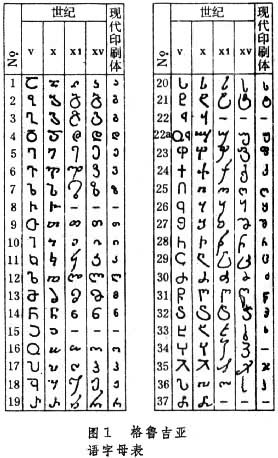
图片:格鲁吉亚语字母2.jpg 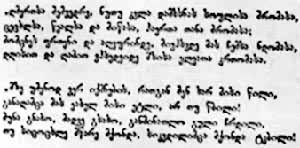 |
|
|
9#
发布于:2008-06-04 12:14
高加索语系-------阿布哈兹语
阿布哈兹语属于阿尔泰语系的突厥语族高加索语支里的西北高加索语的成员,有语言人口十多万人。当中有十万人住在格鲁吉亚,而这十万人当中,又有八万人住在阿布哈兹自治共和国。
分类的争议 阿布哈兹语属于西北高加索语的其中一个成员,顾名思义,源于高加索地区的西北方。西北高加索语跟东北高加索语关系密切,所以有语言学家建议把两者合并为北高加索语系。现时我们把北高加索语跟 南高加索语一起组成高加索语支,但这两种语言其实除了在地理位置上相近以外,两者的关联并不大。 而阿布哈兹语经常都与阿巴扎语一起并称为阿布哈兹-阿巴札语,不过两者的书面语有颇大的分别。即使两种语言的文化非常近似,但他们的音素差异极大。因此,语言学家倾向把两种语言划分为不同的语言。 地理分布 阿布哈兹语的语言人口主要位于格鲁吉亚及土耳其。 官方语言地位 在格鲁吉亚的阿布哈兹自治共和国,格鲁吉亚语及阿布哈兹语都是阿布哈兹的官方语言。 方言 阿布哈兹语总体上看有3种主要的方言, Abzhuy, Bzyp (the Caucasian dialects) and Sadz (在土耳其). 发音 注意:本条目含有Unicode的国际音标字元。 如果你的电脑不支援,有关字元会显示 错误成空格、问号或者方格等。 参看Wikipedia:国际音标字元。 Like the other Northwest Caucasian languages, Abkhaz is very rich in consonants, with 58, but has only a few vowels (either two or three, depending upon the analysis). Below is the IPA phoneme chart for the standard dialect (Abzhuy); the Bzyp dialect has nine additional consonants, and the Sadz dialect has a few less. Labials: p pʼ b v f w m Dentals: t tʼ d n Labialized dentals: tʷ tʼʷ dʷ Alveolar sibilants: ts tsʼ dz s z Labialized alveolar sibilants: tsʷ tsʼʷ dzʷ Palatalized alveolar sibilants: tsʲ tsʼʲ dzʲ sʲ zʲ Postalveolar sibilants: tʃ tʃʼ dʒ ʃ ʒ Labialized postalveolar sibilants: tʃʷ dʒʷ Lateral: l Rhotic trill: r Palatals: kʲ kʼʲ gʲ j Velars: k kʼ g Uvulars: qʼ χ ʁ Palatized uvulars: qʼʲ χʲ ʁʲ Labialized uvulars: qʼʷ χʷ ʁʷ Pharyngeals: ħ ħʷ Labiopalatal semivowel: ɥ (< ʕʷ, a labialized voiced pharyngeal fricative) Vowels: ə a (with allophones and [e] next to palatals, [o] and next to labials) 元音 Abkhaz has only two distinctive vowels: an open vowel /a/ and a close vowel /ı, ǝ/. Depending on the environment both of the vowels can be realized as [e,i,o,u]. 语言类型 Abkhaz is typologically classified as an agglutinative language. Like all other Northwest Caucasian languages, Abkhaz has an extremely complex verbal system coupled with a very simple noun system; Abkhaz distinguishes just two cases, the nominative and the adverbial. 书写系统 Abkhaz has had its own adaptation of the Cyrillic alphabet, the Abkhaz alphabet, since 1862. The first alphabet was a 37 character Cyrillic alphabet invented by Baron Peter von Uslar. In 1909 a 55 letter Cyrillic alphabet was used. A 75-letter Latin script devised by a Georgian linguist Nikolai (Niko) Marr lasted from 1926 to 1928, when another Latin script was used. The Georgian script was imposed in 1937, but after the death of Stalin, an Abkhaz desire to remain separate from Georgians led to the development of the current Cyrillic alphabet in 1954 by Dimitri Gulya who was, ironically, an ethnic Georgian (Mingrealian). 历史沿革 The earliest extant written records of the Abkhazian language are in the Arabic alphabet, recorded by the Turkish traveller Evliya Celebi in the 17th century. Abkhaz has only been used as a literary language for about 100 years. During the Stalinist Russian years Abkhaz was banned as a literary language.. 英文介绍: Abkhaz (аҧсуа бызшәа) Abkhaz is a North West Caucasian language with about 105,000 speakers in Georgia, Turkey and Ukraine. There are two main dialects of Abkhaz: the northern Bzâp dialect and the southern Abz'âwa dialect, upon which literary Abkhaz is based. Both dialects are spoken in Abkhazia, an autonomous republic within Georgia. Abkhaz first appeared in writing in 1862/3 in the Cyrillic alphabet using a spelling system based on the Bzâp dialect and devised by the Russian soldier-linguist Baron Peter von Uslar. Other spelling systems using the Georgian, Latin, and Cyrillic alphabets appeared during the 20th century. The current Cyrillic-based system, which has been in use since 1954, is considered somewhat cumbersome with its 14 extra consonant letters and its inconsistencies. Recently there have been suggestions that a new Latin-based spelling system should be created. The first ever novel in Abkhaz was written by Dârmit' Gulia (1874-1960), who is regarded as the Father of Abkhaz Literature. He also founded the first Abkhaz newspaper, wrote poety, plays, translations, historical and ethnographical writings and lectured on Abkhaz at Tbilisi University. 阿布哈兹语字母 图片:阿布哈兹语字母.jpg 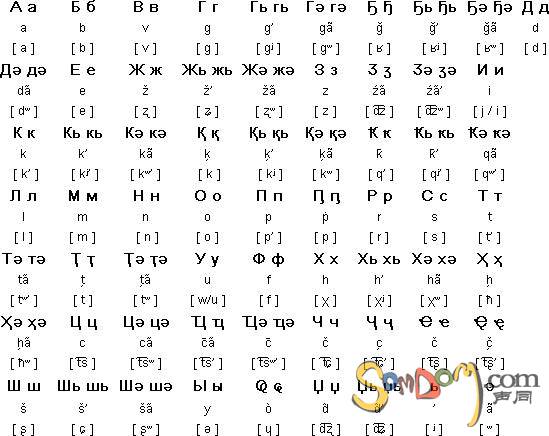 |
|
|
10#
发布于:2008-06-04 12:09
高加索语系------达尔格瓦语
达尔格瓦语属于东北高加索语支,约有 439,000 人的使用者,大部分居住在俄罗斯的达吉斯坦自治共和国。在俄罗斯的卡尔梅克自治共和国,车臣自治共和国和汗特--曼西自治区以及俄罗斯的其他一些地区也有达尔格瓦语使用者。此外,在俄境外的阿塞拜疆,哈萨克斯坦,吉尔吉斯斯坦,土耳其,土库曼斯坦,乌克兰和乌兹别克斯坦,情况同样如此。
1926年以前,达尔格瓦语采用阿拉伯字母书写;1926年~~1937年使用拉丁字母书写;自1937年开始,达尔格瓦语使用一种变体西里尔字母书写至今。 Dargwa (дарган мез) Dargwa or Dargin is a North East Caucasian language with about 439,000 speakers, most of whom live in the Russian republic of Dagestan. There are also Dargwa speakers in the republics of Kalmykia, Khantia-Mansia and Chechnya, in other parts of the Russian Federation, and in Azerbaijan, Kazakhstan, Kyrgyzstan, Turkey, Turkmenistan, Ukraine and Uzbekistan. Dargwa was written with the Arabic alphabet 1926, when the Latin alphabet was adopted. Since 1937 a version of the Cyrillic alphabet has been used to write Dargwa. |
|
|
11#
发布于:2008-06-04 12:07
高加索语系------车臣语
车臣语(Нохчийн мотт, Noxçiyn mott)大约有 1,200,000人使用,大多数使用者住在俄罗斯。车臣语是高加索语系之一。在语言学上,车臣语属于北高加索语族的东北高加索语支,能与印古什语和相邻的语言作部分程度的通话。车臣语在车臣自治共和国约有 950,000 人使用,另外,亦有使用者在中东地区,尤其是约旦。车臣语为俄罗斯车臣自治共和国的官方语言。
东北高加索语语支 Chechen (Noxchiin mott/Нохчийн мотт) Chechen is part of the small family of Nakh-Daghestanian or Northeast Caucasian languages spoken by about 950,000 people in Chechnya. There are also some Chechen speakers in Georgia, Germany, Jordan, Kazakhstan, Kyrgyzstan, Syria, Turkey and Uzbekistan. The Chechens call themselves Noxchi and their language Noxchiin Mott. The name Chechen comes from the town of Cheechan where the Russians first encoutered Chechen speakers. Chechen was originally written with a version of the Arabic alphabet. Between 1923 and 1937 it was written with the Latin alphabet. The Cyrillic alphabet was adopted in 1938, and a new version of the Latin alphabet was adopted in 1992. 车臣语字母 图片:车臣语字母.jpg 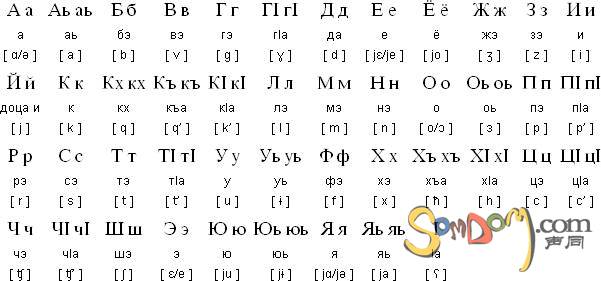 |
|
|
12#
发布于:2008-06-04 12:03
高加索语系-------阿瓦尔语
阿瓦尔语 是东北高加索语族的一种语言,在俄罗斯的达吉斯坦自治共和国和阿塞拜疆的Zakatala 地区约有601,000使用者,在格鲁吉亚,哈萨克斯坦,约旦,土耳其以及俄罗斯的卡尔梅克和车臣自治共和国也有少数使用者。
阿瓦尔语有4种方言:Khunzakh, Antsukh, Charoda 和 Gidatl,这4种方言,在相互的理解上有很少的限制, Khunzakh 方言是阿瓦尔语书面语言形成的基础。 从15世纪到17世纪,阿瓦尔语采用旧格鲁吉亚字母书写系统。17世纪到20世纪早期采用阿拉伯字母书写系统。1928年到1938年使用拉丁字母书写系统。然后,西里尔字母一直沿用至今。 东北高加索语语支 Avar or ma'arul mats is a North East Caucasian language spoken by about 601,000 people mainly in the Russian republic of Dagestan and in the Zakatala region of Azerbaijan. There are also small numbers of speakers in the Russian republics of Chechnya and Kalmykia, in Georgia, Kazakhstan, Jordan and Turkey It has four main dialects: Khunzakh, Antsukh, Charoda and Gidatl, which have only limited mutual intelligibility. The Khunzakh dialect or болмацI (bolmats) acts as a lingua franca between Avar speakers and is the basis for written Avar. Avar was written with the Old Georgian alphabet from the 15th century, and with the Arabic alphabet from the 17th century until the early 20th century. From 1928 to 1938 the Latin alphabet used, then the Cyrillic alphabet became standard. 阿瓦尔语字母 图片:阿瓦尔语字母.jpg 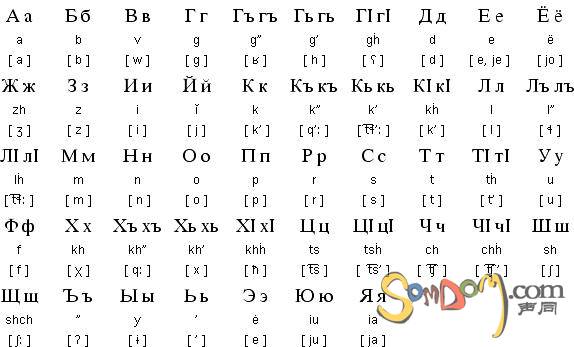 |
|
|
13#
发布于:2008-06-04 09:06
高加索语系-------阿迪格语
阿迪格语是西北高加索语族的一种语言,主要在俄罗斯境内的阿迪格自治共和国和克拉斯诺达尔边疆区内有
300,000 使用者,在澳大利亚,埃及,法国,德国,伊拉克,以色列,约旦,马其顿,荷兰,叙利亚,土耳其和美国也有少数使用者。 在1918年~~1927年期间,阿迪格语采用阿拉伯语书写系统,1927年~~1938年,采用拉丁字母书写系统,自1938年起,使用西里尔字母书写系统。书面语言主要取自于Chemguy方言。 Adyghe (адыгэбзэ) Adyghe is a North West Caucasian language spoken by about 300,000 people mainly in the Russian republics of Adygea and Krasnodar. It is also spoken in Australia, Egypt, France, Germany, Iraq, Israel, Jordan, Macedonia, Netherlands, Syria, Turkey and the USA Adyghe was written with the Arabic alphabet from 1918 to 1927. The Latin alphabet was used until 1938, and then the Cyrillic alphabet was adopted. The literary language is based on the Chemguy dialect. |
|
|
14#
发布于:2008-06-04 08:52
高加索语系------阿巴札语
高加索语言
高加索语言泛指来源于高加索地区的语言,共同结合为高加索语系,其归属及分类均存争议。一般来说,高加索语系分为2或3种语族,包括东北高加索语族、西北高加索语族和南高加索语族,也有的把东北和西北高加索语族合并为北高加索语族。 而在高加索地区,亦有一些语言不属于任何一种高加索语系,包括: 印欧语系:亚美尼亚语、希腊语、库尔德语、奥塞梯语、Talysh、俄语 阿尔泰语系:阿塞拜疆语、卡拉切-巴尔卡尔语、卡拉切语、Kumyk、Nogay、土库曼语、卡尔梅克语 分类 高加索语系 南高加索语族(又称 Kartvelian) 格鲁吉亚语 (kat) 犹太-格鲁吉亚语 (Gruzinic) (jge) 斯万语 (Svan) (sva) 拉兹语 (Laz) (lzz) Megrelian (Margaluri) 北高加索语系族 西北高加索语支 阿布哈兹语 (abk) 阿巴札语 (abq) 阿迪格语 (ady) 卡巴尔达语 (kbd) 尤比克语(Ubykh) (uby) 东北高加索语支 Bats (bbl) 车臣语 (che) 印古什语 (inh) Akhvakh (akv) Andi (ani) Botlikh (bph) Chamalal (cji) Ghodoberi (gdo) Karata (kpt) Bagvaval (kva) Tindi (tin) 阿瓦尔语 (Avar) (ava) 达尔格瓦语 (Dargwa) (dar) Khinalugh (kjj) 拉克语 (Lak) (lbe) Archi (aqc) Aghul (agx) 莱兹金语 (Lezgi) (lez) 塔巴萨兰语 (Tabassaran) (tab) Budukh (bdk) Kryts (kry) Rutul (rut) Taskhur (tkr) Udi (udi) Hunzib (huz) Bezhta (kap) Dido (ddo) Hinukh (gin) Khvarshi (khv) 阿巴札语是高加索语系西北高加索语支的一种语言,在俄罗斯境内的卡拉恰耶夫----切尔克斯自治共和共和国和阿迪格自治共和国,在德国,土耳其和美国也有使用者,此语言和阿布哈兹相近并且在一定程度上相通。 像其他高加索语系的语言一样,阿巴札语有许多辅音(63个)和极少数的元音,正因为如此,阿巴札语被语言学家视为最难学习的语言之一。 1932~1932期间阿巴札语的书写系统采用拉丁字母系统书写,然而,从1938年开始此语言采用西里尔字母书写系统(如图所表示)。在土耳其阿巴札语一直采用拉丁字母系统书写。 原文:Abaza (абаза бызшва) Abaza is a North West Caucasian language spoken by about 45,000 people in the Russian autonomous republics of Karachay-Cherkessia and Adygea, and also in Germany, Turkey and the USA. It is fairly closely related to Abkhaz and is intelligible with it to some extent. Like other Caucasian languages, Abaza has a large number of consonants (63) and few vowels. As a result, it is considered by linguists to be one of the most difficult Caucasian languages to learn Between 1932 and 1938 Abaza was written with the Latin alphabet. Since 1938 however, it has been written with the version of the Cyrillic alphabet shown below. In Turkey it is still written with the Latin alphabet 阿巴札语字母 图片:29790130325c938aa9018ea9.jpg 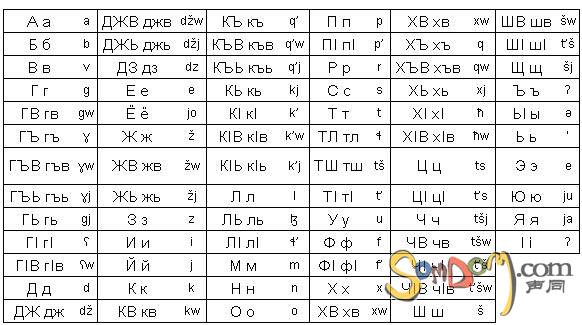 [ 本帖最后由 小菜菜 于 2008-6-4 08:56 编辑 ] |
|


